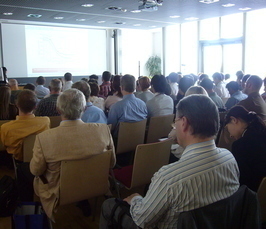MPI Kolloquiumsreihe: Prof. Gregory S. Yablonsky, Chemical Calculus: A New Paradigm of Chemical Kinetics
MPI Kolloquiumsreihe: Prof. Gregory S. Yablonsky, Chemical Calculus: A New Paradigm of Chemical Kinetics
- Datum: 13.06.2019
- Uhrzeit: 16:00 - 17:00
- Vortragende(r): Prof. Gregory S. Yablonsky
- Department of Energy, Environmental and Chemical Engineering, Washington University in St. Louis
- Ort: Max-Planck-Institut Magdeburg
- Raum: Großer Seminarraum "Prigogine"
- Kontakt: sek-bpe@mpi-magdeburg.mpg.de

Das Max-Planck-Institut Magdeburg lädt Sie herzlich zu seiner öffentlichen Kolloquiumsreihe ein. Hochrangige WissenschaftlerInnen verschiedener Fachgebiete aus renommierten Forschungseinrichtungen aus Deutschland und weltweit präsentieren ihre Forschungsarbeit.
Abstract
A new paradigm for understanding the complexity of chemical
reactions materials and a new approach to creating and understanding the
complex solid active materials, catalysts, are proposed. It focuses on
non-steady-state studies and challenges the traditional methods of
design/studies of model systems or high-throughput screening of composition
libraries under steady-state conditions. The approach is a further development
of Temporal Analysis of Products (TAP) – method which experimental technique
and methodology, and theory and different applications as well have been
proposed by Gleaves (1988) and Gleaves and Yablonsky (1997). In the
TAP-approach, systematic small stepwise changes in catalyst surface composition
are combined with precise kinetic characterization after each change to
elucidate the evolution of catalyst properties and provide information on the
relationship between surface composition and kinetic properties. Three
principles of the TAP-experiment are the following ones: (1) Insignificant
change of catalyst composition during the single pulse; (2) Controlled change
of catalyst composition during the series of pulses; (3) Uniformity of the
active zone regarding its composition.
Based on the new theory (so called Y-procedure) and corresponding software, the Thin-Zone-TAP-reactor (TZTR)-experiments provide with unique data, i.e. the non-steady-state concentration, transformation rate and uptakes/releases in the active catalytic zone without any a priori assumption about the type of kinetic dependence. Then, the TAP-approach will be used for determining the number of active sites and kinetic parameters of active materials, and, finally, for revealing the detailed mechanism of complex catalytic reaction.
The presented approach will be illustrated by the examples related to reactions of complete and partial oxidation, and decomposition of ammonia.
Ideas of Chemical Calculus which theory and methodology recently were described in detail can be expanded into many different areas and systems, e.g. for design of sensors, semiconductors and drugs etc.